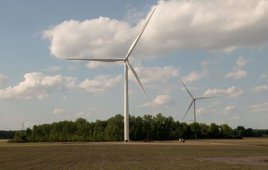Slip rings work in the turbine’s hub where they transmit power and signals from stationary cables in the nacelle to rotating equipment in the hub. A slip-ring assembly is often a graphite or precious-metal brush, which contacts the outside diameter of a rotating metal ring. As the ring turns, electrical current or signal conducts through the stationary brush to the metal ring making the connection. Additional ring-brush assemblies are stacked along the rotating axis for more electrical circuits.
In pitch slip rings, new design trends are on at least two fronts. “First, as turbine designs increase in power output and size, the demand on the pitch slip ring is higher power transfer,” says Moog’s Senior Business Development Manager Steve Black “Second, data handling and signal demands are increasing to provide additional condition monitoring in the hub. It is critical that the contact technologies be durable enough to handle power peaks at the extremes of operation.” Equally important is a need to protect data lines from potential cross talk (stray signals or noise) from power lines.
Another trend is toward more complete pitch controls. “These would include hub controls, pitch-drive motors, power back-up, blade monitoring, and the slip ring to transfer the power and control signals through the rotary interface,” say Black. The company supplies complete systems to the OEM and also offers aftermarket pitch slip rings to improve system performance.
Look, too, for new pitch-control slip rings in the aftermarket. “The wind-turbine service market is growing tremendously as the turbine population ages and asset owners are looking for ways to control maintenance costs, and maximize turbine availability and output,” says Black. “Products should be able to replace slip rings in older turbines with long-life, high-reliability designs to provide pitch slip rings that can operate for years without maintenance.”
Ideal pitch slip rings would be installed and forgotten. Many designs in use today require periodic maintenance to clean away wear debris, flush out oil and dirt, and relubricate. Replacing the entire slip ring comes at intervals that are too frequent. Keeping the turbine technicians out of the nacelle will keep costs down and outputs up. “That is the goal for asset owners and the focus of efforts in the aftermarket portion of our wind energy business,” says Black.
The high-reliability quest has encouraged some companies to devise non-contacting slip rings. One is an inductively coupled power transfer device. Inductive-power transfer applies the principle of electromagnetic inductance. One manufacturer, New Zeeland-base PowerbyProxi, says its slip rings work at high efficiencies by using wireless power transfer that can harmonize itself in the field. The company says this makes the systems resistant to changes in environmental conditions and load variations.
For wireless power, transmission distances can extend to 6 to 8 ft, but efficiency levels between transmitter and receiver are low. When transmission distances are less than 8 in., efficiencies exceed 90%.
Power transmits as a single load while a built-in data-communications system switches power, for example, to meet different device requirements of wireless receivers. In this way, the slip rings provide wireless power and data to pitch control in wind turbines, improving efficiency by reducing the cost of maintaining and replacing existing mechanical slip rings and their carbon brushes. Any size turbine can be supported, says the company. WPE
Filed Under: Uncategorized





Good article, thanks for share
more slip ring information: http://www.arslipring.com
more slip ring information , click http://www.moflon.com
We are looking forward slip ring in 2014: http://www.moflon.com